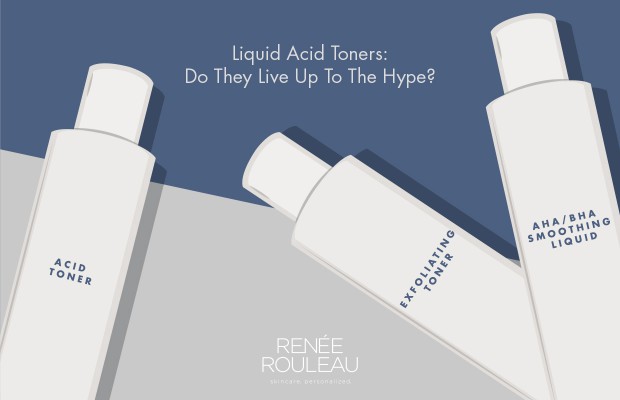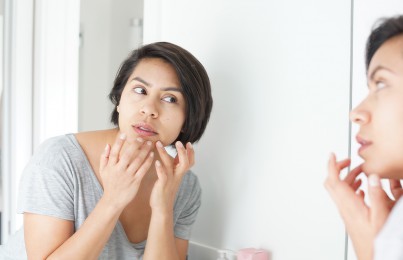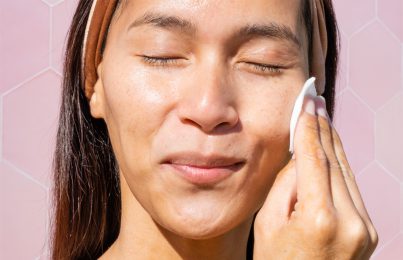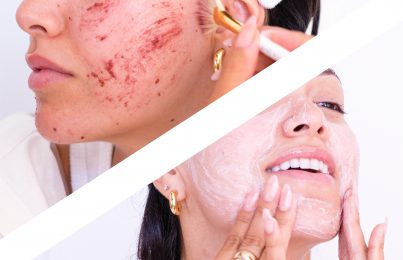Why liquid exfoliating toners may be harming your skin.
The use of liquid exfoliating toners and tonics with ingredients like glycolic, salicylic and lactic acid are rapidly increasing in popularity. These types of toners are being used once or twice a day after cleansing, as a way to exfoliate (remove surface dry skin cells) and give a smooth appearance to the skin. While exfoliating and smoothing the skin are the desired result for most everyone, I’m seeing a lot of damage being caused from using exfoliating liquids too often, which leads to poor results for the skin’s overall health.
In this post, I’ll give a history of toners and tonics, the benefits of exfoliating the skin and why liquid exfoliators with acids may not be the best way to remove and smooth away dry, dead surface cells. Additionally, I’ll share my expert advice for other exfoliating solutions and the reasons as to why they might work better for the health and integrity of your skin.
What is a toner or tonic and what are they used for?
It’s important for you to know the history of a liquid toner, astringent and tonic because I believe it drives the behavior of how they are being used today. I have 30 years of experience in the wild world of the skincare industry and I have seen how it has evolved throughout the years. However, it was, and still is, a very exciting profession for someone like me who loves forward momentum and is open-minded to change.
Toners in the 1970s and 1980s,
(and even long before then), were called “astringents,” and were loaded with solvent alcohols like SD alcohol 40 and denatured alcohol, as well as camphor and peppermint. They were wildly popular (who remembers Sea Breeze and Bonne Bell’s Ten-O-Six?) and recommended to wipe over the skin after washing the face as a way to remove oil, refresh the skin and prevent blemishes. Since the formulas were loaded with menthol, camphor, and a strong solvent alcohol, you could really feel a tingling sensation on the skin, and this made you feel like something was really happening. (Yes, something was. It was causing major dehydration and irritation!)
Then, of course, were the days when there was a very popular skincare line made famous for its 3-step routine. One of the toners was called a “clarifying lotion” and it actually contained acetone. As you probably know, this ingredient is commonly used in nail polish remover! Whenever I had a new client come in and he or she would tell me they were using this product, I would give a quick demonstration. I would grab this mannequin hand I had that was used in manicure schools for the students to practice painting on nail polish. All of the nails had been painted. I had a sample of the clarifying lotion and I would apply it to cotton and show them how quickly the nail polish would come off the nails. It made quite an impact on the strength of this so-called skincare product!
In the early 90’s,
skin experts (myself included), finally realized that wiping alcohol over the face was very dehydrating to the skin and caused surface cell build up. A tight feeling wasn’t an indication of the skin being “clean”, but rather a sign that water had been depleted from the skin. This was actually causing more oil to be produced in oily skin types, resulting in increased clogged bumps and breakouts.
Around this time, an exfoliant named glycolic acid was starting to hit the professional market. This acid was designed to do the exact opposite of an alcohol-based astringent. It was meant to actually remove surface dry skin cells, unlike alcohol which was only causing more of them to build up on the face. The results of using glycolic acid were smoother-looking skin with less dryness and fewer blocked pores and blemishes. For those with acne, this was a very exciting time because, up until then, treating breakouts with homecare products wasn’t very effective. I was now able to give amazing results for my clients. Many people saw oral prescription pills and drying topical prescription creams as their only option.
By 2000,
toners had dropped in popularity and were no longer seen as an important step in a skincare routine. My belief is that once gentler, alcohol-free versions were being promoted, people no longer felt any sort of sensation on the skin, and perceived them as not doing very much. It left people uninspired to use them as an additional step in their routine.
In 2018,
we’re seeing a rise in popularity of toners again, but this time around, acids like glycolic, lactic and salicylic are being used in the formulas, so it’s more of an exfoliating step. Since acids can bring on a tingling sensation due to putting the skin in an acidic state, people now “feel” them working again. In some cases, you might even find the ingredient phenol being used along with an acid which can give a serious stinging feel to the skin. Many people have fallen into the dangerous mindset of “it’s burning, so it must be working” and because of this, have now found them worthy of the extra step in their routine.
While I’m happy about people getting back into using a liquid toner again, you have to understand what is happening to your skin when you are using ones that contain acids so you’re not over-doing it.
Let’s first start with the basics in case you’re new to the concept of exfoliating the skin.
What benefits does exfoliation give?
Many. I am a true believer in exfoliation and as an esthetician who works hands-on with clients, I have seen how it can truly transform the skin.
Benefits of exfoliation include:
- Clearer skin with fewer bumps and breakout activity
- Fewer visible lines and wrinkles around the eyes.
- Targets early wrinkles
- Dissolves away pigmented cells (brown/sun spots, melasma, post-breakout dark marks)
- Makes large pores appear smaller
- Encourages the skin to act younger
- Enhances the overall performance of your skincare products
- An overall smoother, brighter and more even-toned complexion
- Makeup goes on more smoothly
- Safe for all skin types as long as you’re choosing the right formula for the unique needs of your skin. Take my Skin Type Quiz to get the best exfoliant recommended.
- When used in a formula exclusively for the body, can help manage bumps and rough skin known as keratosis pilaris.
What is the problem with using an acid exfoliator in the form of a liquid toner?
What I see as a problem is that now many people are changing up the benefits that an alcohol-free, non-exfoliating toner is designed to give (read the benefits here) to that of an exfoliant step in their routine. In some cases, people are using it twice daily every day which I believe is much too often. Then, aside from that, they might also be using other exfoliating products in their routines, such as an acid serum, a facial scrub and a sonic cleansing brush which can result in damage and inflammation to the skin. (A brush such as Clarisonic actually acts as a method of exfoliation despite it being marketed as a way to clean the skin. Read my Clarisonic review).
Trust me when I say, too much daily exfoliation is causing serious harm to your skin even if you can’t see it. The underlying cause of premature skin aging is inflammation, and frequent exfoliation is one of the many culprits. Read what happens to your skin when you exfoliate too much.
Why does my skin look so good after I do acid toning?
So here is the interesting thing. Watch this video of a client I saw who was using an exfoliating liquid toner just once a day, but even with that, her skin was not in a healthy place because of the severe dehydration. However, what will happen as a result of water loss to the skin’s surface is that the skin gets really tight, and when makeup is applied, the skin does, in fact, appear smoother. The same thing occurs after I do a chemical peel on a client. For the first two days before the skin gets dry and flaky, clients love the tight feeling and how the texture gets super smooth and pores look almost invisible. In fact, I’ve been known to occasionally use stronger products on both my own skin as well as my client’s skin, the night before a special event just to give a temporary smoother texture. I’m all for the skin looking good and pores looking invisible (what a dream!) but long-term, it’s simply not in a healthy place when it doesn’t have the water it needs. Like our bodies, skin cells need water to live. (When it comes to skin, is your skin dry or dehydrated? There is a difference and you really need to know what it is. Read here.)
Is an acid-based liquid toner the best way to exfoliate the skin?
No. In my professional opinion, I don’t believe so. I think that exfoliating acids used in a gel/serum formulation are much better than using acids in a liquid/water/toner form.
PROS of an exfoliating liquid toner:
- Fast penetration so they work quickly to give visible results.
- Easy to use. Wipe and go.
CONS of an exfoliating liquid toner
- Water evaporates quickly so the results aren’t long-lasting but they do provide exfoliating benefits.
- Can give an increased stinging sensation. (Water penetrates fast and deep due to its molecular size, so this can hit the nerve endings causing it to be felt more.)
- Not always travel-friendly. (Like with any water-based liquid, they are more prone to leaking in a suitcase. An acid toner has the capability of doing damage to whatever it spills onto since it has a low pH.)
PROS of an exfoliating acid serum:
- Less stinging since the release into the skin is slower. (Better for sensitive skin.)
- Gives longer-lasting results since it stays active on the skin for longer and works deeper. (Since serums have a gel or lotion consistency, they can “hug” and coat the skin for hours which is why they are ideal for use at bedtime)
- Gives hydrating benefits that last. (The goal when dissolving off old cells is to hydrate the new cells. Serums use humectants that ensure the new skin cells stay hydrated throughout the exfoliation process.)
CONS of an exfoliating acid serum:
- Must be a bit more careful with application. (A gel/serum formula is more likely to settle in areas with crevices like the corners of the nose which could result in too much exfoliation.)
Note: With any exfoliating acid product, regardless of its form, only purchase from a trusted source. In poorly made formulations, the pH can fluctuate and cause instability, which can put your skin at risk for a chemical burn. Beware of homemade acid exfoliators!
Let me make something clear about my opinion. I have my own skincare line that currently has 46 products, and many of them include formulas that give exfoliation since I am such a believer in the results they will give. I have almost 30 years of experience working with acid-based exfoliators, and I could easily come out with a liquid toner if I wanted to add it to my line. In fact, they are pretty easy to make. Instead, I have chosen to formulate exfoliating products in other bases (gels and creams versus water) as I feel they are safer and better. However, make no mistake, you can overdo it with any type of exfoliant as they should never be used seven days a week, 365 days a year.
I believe there is a time and a place for when, and how often, you should use them within a skincare routine, which is generally three nights on, three nights off each week. This is how I recommend using acid serums such as Pore + Wrinkle Perfecting Serum and Pro Results Power Serum. I offer my own solutions for nine different types of skin. Take my Skin Type Quiz to get a customized skincare routine.
If you’re someone who has been using a liquid acid toner or tonic 4-5 times a week and is happy with the results, then you certainly have my blessing. The most important thing is to not exfoliate every single day. There are many different philosophies when it comes to skin. You are simply reading mine, but my goal is to provide you with insight so you can make informed decisions.
Want more info about exfoliation and how often you should be doing it to your skin? Read my beginner’s guide to using exfoliants.
if you’re someone who is into using home skincare devices and tools, you’ll enjoy reading this review.
Celebrity Esthetician & Skincare Expert
As an esthetician trained in cosmetic chemistry, Renée Rouleau has spent 30 years researching skin, educating her audience, and building an award-winning line of products. Her hands-on experience as an esthetician and trusted skin care expert has created a real-world solution — products that are formulated for nine different types of skin so your face will get exactly what it needs to look and feel its best. Trusted by celebrities, editors, bloggers, and skincare obsessives around the globe, her vast real-world knowledge and constant research are why Marie Claire calls her “the most passionate skin practitioner we know.”



